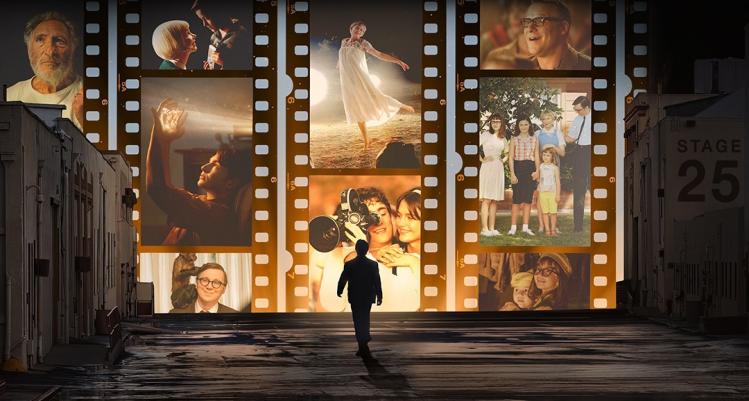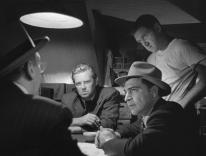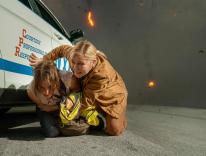
Two films, two views of filmmaking—and of film’s relationship to memory. Not two philosophies or programs, but two views, arising spontaneously from very different sensibilities. One of the filmmakers, Steven Spielberg, is among the most successful in the history of Hollywood; the other, Charlotte Wells, is still at the beginning of her career, but her focus is already clear, and it is very different from his.
Spielberg’s The Fabelmans opens with a young boy’s introduction to the power of cinema. His face bathed in the projector’s flickering glow, Sammy Fabelman watches the climax of The Greatest Show on Earth, his mouth wide with awe as a pair of criminals crash into a Barnum & Bailey train, sending their convertible flying. It’s a quintessential piece of Spielbergian Americana: the collision of technology and art sparking wonderment in the mind of a child.
This, anyway, is how the film’s disastrous marketing campaign presents the scene. Because, in fact, young Sammy isn’t impressed or inspired, much less awestruck: he’s terrified at the violence at the heart of the spectacle, the ease with which human life can be discarded, smashed, reduced to nothing for entertainment. When his father (Paul Dano) gives Sammy a train for Hanukkah, he almost breaks it as he reenacts the crash scene in the movie. It takes his mother, Mitzi (Oscar-nominated Michelle Williams) to recognize that he’s trying to take control of his fear by recreating it, as if he might contain the horror by holding it in his hands. So she offers him a compromise: if they film the crash with his father’s camera, Sammy can reenact it as often as he likes, no damage required. His home movie is full of cuts and perspective shifts, a tiny spectacle in its own right. He contains his terror by transforming it into art.
Which is also to say: into entertainment. Spielberg is our master entertainer, imbuing even his grimmest films with visual and narrative zip. (Not for nothing did Michael Haneke accuse Spielberg of treating the Holocaust like a horror movie.) The Fabelmans dives right into that contradiction, a film about a boy using the movies as a shield against pain, and a film that uses all of cinema’s tricks to delve into that pain.
Soon we see a teenaged Sammy (Gabriel LaBelle) throw himself into filmmaking, enlisting all his pals to help him earn merit badges. But at home, his life is coming apart. After the family moves to California, Mitzi falls into a deep depression, unable to balance her desire to keep her family together with the knowledge that she simply cannot be happy in her marriage anymore. Again and again, Spielberg inverts his trademark tricks. At one point, Sammy discovers that he has inadvertently filmed evidence of his mother’s infidelity on a family camping trip. He cuts out the offending clips and shows only the happy bits to his family, constructing the scene out of compounded deceptions: Mitzi’s, Sammy’s, Spielberg’s. When Sammy does finally confront his mother, Spielberg uses his most iconic trick, showing Mitzi’s face as she responds with shock and disappointment and finally shame to the secret film—and to the knowledge that her own despair has infected her son. Once again, art is presented as a vessel for pain. It can wound but it cannot heal.
That is one view of the filmmaker’s art; happily, there are others. Aftersun is the autobiographical debut feature from Scottish filmmaker Charlotte Wells. Calum (Paul Mescal) has taken his daughter Sophie (Frankie Corio) on a vacation to Turkey to celebrate his thirty-first birthday. Calum had Sophie when he was very young, and the intervening eleven years have been hard on him. He moved to London, far from the girl and her mother in Edinburgh. He arrives in Turkey with his arm in a cast, unable to remember how he broke it. “I don’t know how I made it to thirty,” he tells a total stranger. “I can’t imagine myself at forty.”
Sophie senses her father’s restless unhappiness, even if she can’t quite make sense of it. At times Calum is almost oppressively generous, lavishing attention on her and buying her gifts he can’t afford. Yet just as often he recoils from parenthood, diving to depths where Sophie can’t follow, even disappearing in the middle of the night and leaving his daughter locked out of their room. He is trying to manage a life that he finds unbearable, and to care for a daughter he loves but cannot help disappointing.
Wells presents their relationship as a wavering back and forth. Whenever one of them approaches, the other withdraws, so that every step closer is also a step back. Calum’s affection causes Sophie to pull back; his (implied) death draws her memory toward him, when he is far beyond her. Their only point of contact is a video camera that Calum seems to have purchased for the trip. Calum films Sophie by the pool and in their room while Sophie films them both, questioning her father about his own childhood and mugging for the camera when he’s gone. Calum goes back through the footage when he’s alone, perhaps hoping to hold on to the day—to prove that his daughter loves him, and that he is happy.
Aftersun is poised on a precipice where memory can easily slip. Image and sound frequently fall out of sync, and scenes dissolve into one another without a clear connection. Wells prefers gestures and moments, and her camera lingers on details that feel at once charged and opaque: a teen girl’s bra strap, a mouthful of toothpaste spat onto a mirror. Wells shoots her two main characters through reflective surfaces and divided by barriers, separated even when they occupy the same frame.
This delicate waltz is at the heart of the film. Calum sees the beginnings of his restlessness and depression in his daughter, but his attempts to reach her are feeble, reflecting his essential helplessness. Sophie observes this all without quite comprehending it; and when he pulls her toward him, she pushes him away. By the time she recognizes her father in herself, he is beyond her reach.
She is left with only that camera. We see snatches of footage throughout the film, as an older Sophie, perhaps approaching the age of her father then, re-watches their video recordings. She can return to these moments, can see herself as she once was, as her father was in life—and yet there will always come a point at which the tape runs out. Every moment spent with the footage is a moment without her father, a moment further from their time together and from the day of his death.
After his mother’s death, Roland Barthes went looking for her in his collection of her photographs. He discovered that he could not recognize the woman he knew, a realization that quickly grew into distress. “To say,” he writes in Camera Lucida, “confronted with a certain photograph, ‘That’s almost the way she was!’ was more distressing than to say, confronted with another, ‘That’s not the way she was at all.’” It is only in an image of his mother at five years old, decades before his own birth, that Barthes at last recognizes “the impossible science of the unique being,” those qualities essential to his mother as he knew her. Nothing else has been preserved “except in fragments.”
The essential tragedy of photography lies in how it freezes moments without stopping time, creating a record of things that it cannot actually preserve. Similarly, art might allow the artist to respond to the unbearable, to take hold of their fears and traumas and perhaps to make something new from their pain, but it cannot recover the lost or make the broken whole. It brings the dead to life through imitation, as simulacra.
Aftersun ends with father and daughter pointing their cameras at one another, one filming, the other watching, still somehow connected by the images spooling out on this one cassette. Wells visualizes the hope I think all artists harbor, that through their work the living might hear from the dead. And then Calum closes the camera’s screen, the lens jitters shut, and he crosses that threshold into the unviewed, the unviewable.
Please email comments to [email protected] and join the conversation on our Facebook page.


